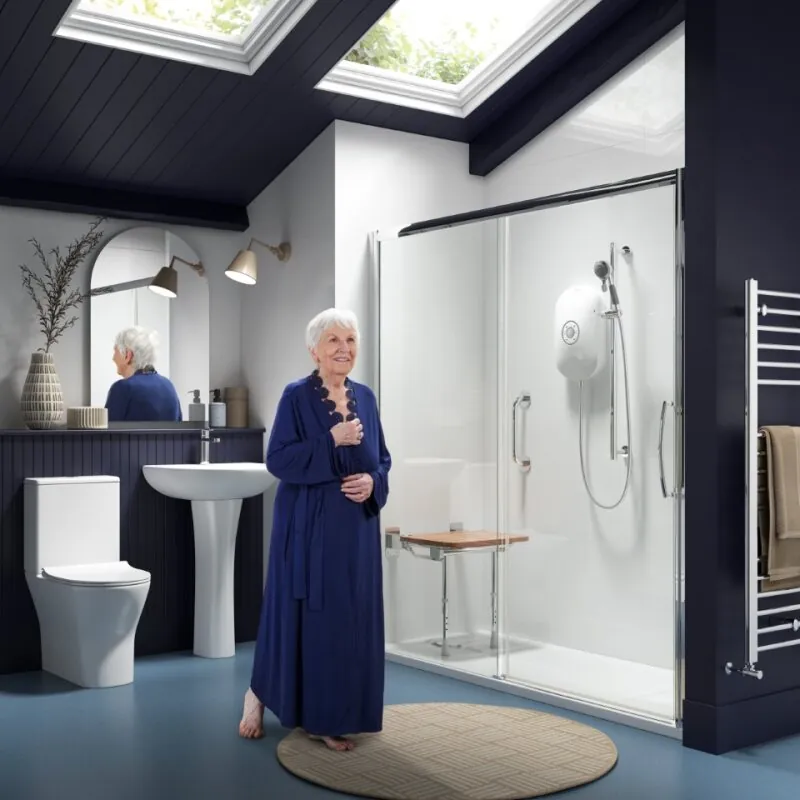
If you struggle with mobility issues or use a wheelchair, you’ll know how making concessions within your to your home, in particular the bathroom, is essential for independent living.
Not everyone wants assistance in the bathroom, which is perfectly understandable. So, instead of struggling in a bathroom that doesn’t suit your needs, adapt it to fit you. In this article, you’ll find the best bathroom aids and preparation tips for the elderly and those with mobility issues for independent living.
Get a FREE Brochure
Simply complete our form to see a full range of bathing solutions & their key features. It takes no time at all!
- What is independent living?
- Independent living bathroom habits and mindsets when experiencing a mobility disability
- Mobility adaptions you can add to the bathroom
- How to best design your bathroom to suit your needs
- Transform your bathroom for independent living with Bathing Solutions
What is independent living?
Independent living is when a person has the autonomy to care for themselves without assistance. Of course, that isn’t always possible for the elderly or disabled. However, providing as much freedom as possible is excellent for confidence and self-reliance.
Creating an environment to live independently involves adapting the space to suit the needs of the individual. This is better than struggling with a house that isn’t designed for mobility issues. It allows less mobile people to carry out activities or daily tasks without requiring support.
Independent living bathroom habits and mindsets
There is no doubt that mobility issues in the bathroom are challenging. Lowering yourself into the tub is painful, and showering can be exhausting. All these things can cause a loss of independence, but it doesn’t have to be that way. Below are some habits and mindset tips to promote independent living in your daily bathroom routine.
Take it slow
When living independently, remember there is no need to rush as this can cause you to slip or lose balance. When you move at your own pace, you reduce the risk of accidents. This simple but small mindset will ease your loved one’s worries and enable you to enjoy your privacy. So, take your time navigating across the bathroom and use aids to help you.
Change the environment to suit you
Don’t struggle in an environment that isn’t adapted to suit your needs. Instead, investigate the space and ask yourself, ‘What would make using the bathroom easier?’ ‘Are there things that could improve my independence?’
You should also consider what’s making things challenging. Are you worried about slipping on the floor? Are the taps too stiff, or is the tub too deep? These are all questions to consider when the goal is to improve independent living.
Take advantage of bathroom aids
Install bathroom supports, and ensure you use them. There are products designed specifically to enhance your autonomy in the bathroom (which you’ll find in the next section).
If you’re not used to aids, don’t worry. Look around the room when you enter and make your way towards the ones that will help you. Before long, using them becomes an instinctive habit.
Mobility adaptions for your bathroom
The bathroom is usually one of the first places that requires upgrading for independent living. Bathroom adaptation for the elderly reduces slip risk so you can relax in your home. Below are a few bathroom aids for the elderly for higher-quality living.
Bathroom grab rails
A simple solution to assist independent living is installing grab rails in the bathroom. Place them near the toilet, shower and bath to help hoist yourself up and lower yourself down. They are simple to install and barely take up any space. You can get grab rails to screw into the wall or suction rails, which are fantastic to take with you when visiting others.
Non-slip mats
No matter your mobility, non-slip mats are essential. However, they’re even more important if you struggle with balance and stability.
Non-slip mats suction onto the bottom of baths and showers, creating grip and friction between your feet and slippery bathroom surfaces. They can provide peace of mind when stepping in and out to wash yourself.
Bathroom steps
You are not alone if you enjoy baths but struggle to get in and out. Thousands of elderly people or those with mobility issues resign to only taking showers if their bath is inaccessible. Getting bathroom steps could be your answer.
Bathroom steps are one single or set of steps that bridge the gap between the bathroom floor and the rim of the tub. They prevent the painful process of lifting yourself in and out of the bath. Instead, depending on your mobility, you can use the steps without needing assistance.
Shower seats
Showering is a quick and peaceful way to manage your hygiene. But standing up long enough can be exhausting or dangerous if you can’t keep your balance. Make the experience more accessible by adding a shower stool. You can get ones that are free-standing to move around as you please. Alternatively, fold-down seats attached to the wall are a great space-saving option.
Walk-in bathtub
If you love to bathe, then good news. You can get walk-in baths with low doors that don’t require you to step up and inside. They are watertight and allow you to relax without assistance. If you don’t have space for a full-length bath, consider a compact design that can fit into corners.
How to best design your bathroom to suit your needs
Just because you adapt your bathroom to suit your needs doesn’t mean it has to look drab. You can design a space that is both aesthetically pleasing and functional. Here are a few things to consider when changing your bathroom to accommodate mobility issues for the elderly and disabled.
Have your toilet at a height that suits you
If you use a wheelchair, you may want a low toilet seat, making it easy to transfer yourself without assistance. Alternatively, a higher toilet could be more comfortable. You don’t have to bend as much or struggle to pull yourself up.
Grab rails are practical near toilets for this exact reason, and you may want to install one for a better user experience. Many toilets have smooth rims and smart flush systems, making them both sleek and practical.
Install a walk-in shower or wet room
Standard walk-in showers are shower cubicles or a bath-shower combo, and they often require you to step up into them. These can be hard to use if you have painful mobility issues and find balancing unsupported a challenge. They are also tricky to get into if you are a wheelchair user.
Walk-in showers are just as they sound – showers you walk into without the use of a step. They are often larger, giving you more space to manoeuvre.
Wet rooms are large versions of walk-in showers, except the shower isn’t in an independent cubicle. Instead, the floor has a drainage hole for water to run down. The open space of wet rooms is also accommodating for wheelchairs.
Transform your bathroom for independent living with Bathing Solutions
You don’t have to rely on others to use your bathroom. Instead, convert it into a safe and stable space with the best bathroom aids for convenience and ease. You can shower in peace, use the tub pain-free and enjoy your privacy. Independent living is just around the corner with Bathing Solutions.






